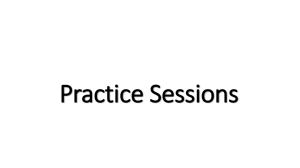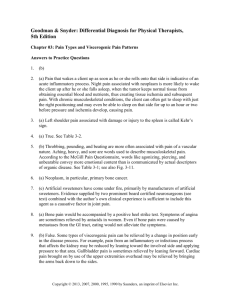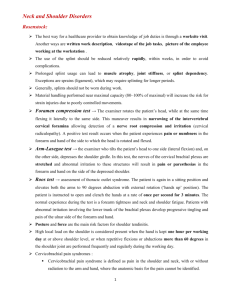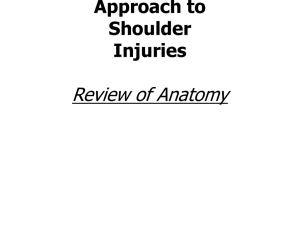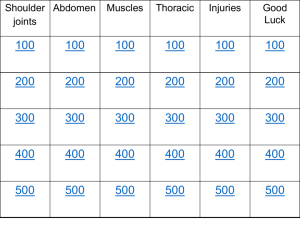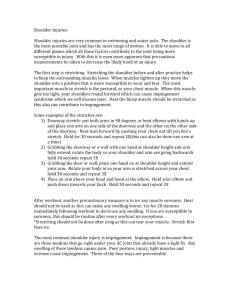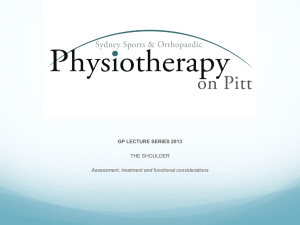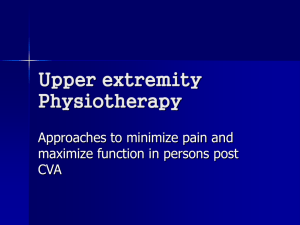Yoga for Shoulder Rehab
advertisement
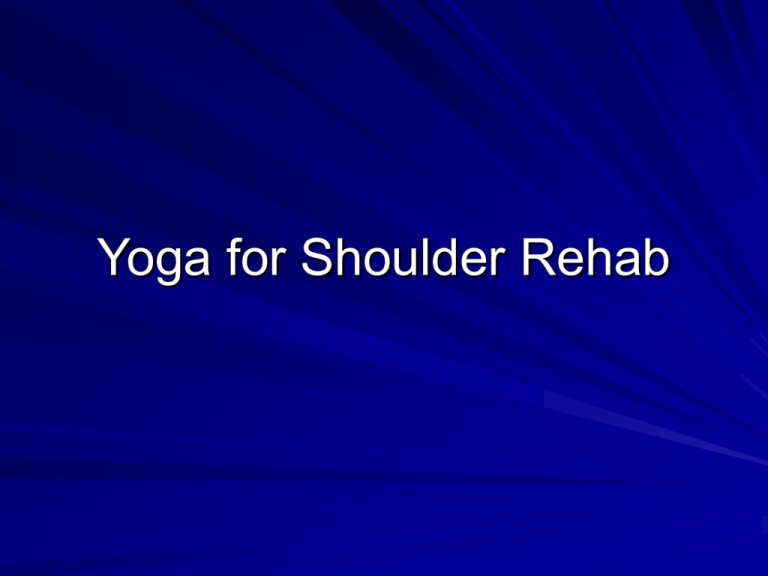
Yoga for Shoulder Rehab The Rotator Cuff Supraspinatus Infraspinatus Teres minor subscapularis Secondary stabilizers Trapezius Rhomboids Latisimus dorsi Pectoralis major and minor Serratus anterior Triceps Bones that make the frame Scapula Humerus Ribcage Clavicle/sternum Cartilage (soft parts) The labrum The capsule Movement Rotation (circumduction) Abduction Adduction Extension Flexion Standard exercises Overhead press Lateral raise Upright rows Internal/External rotation therabands Shoulder shrugs Incline bench press The better way! Mountain Down dog Bridge Shoulder stand Plank Lord fish Mountain Downward Facing Dog Bridge Shoulder Stand Plank Lord of the Fish Crow Pointers for injured shoulder Work first to mobilize the shoulder girdle Control pain (spasm) flare up with usual measures After flexibility is gained, work on muscle “tone” and continued flexibility (exhale and push) Once accustomed to movement, advance to shoulder challenging poses Understand pathology Most common injury is rotator cuff overuse and inflammation/tear The space between the humerus and the acromial arch is narrow thus creating a “guillotine” especially if the scapula moves poorly (as in fatigue or sloppy movment) Once injured, the shoulder joint collects more fluid than it is used to holding (bursa) Frozen shoulder ensues causing smaller space and poor perfusion of muscle and tighter shoulder space etc etc Surgical pathology Once the movement of the scapula is impaired, the humeral head will not sit correctly in the glenoid fossa and it will start to clunk out of space tearing labrum (cartilage) or muscle (supraspinatus) Attempt physical therapy with a ‘shoulder trained therapist’ Time for surgeon or injection with conventional medicine …….or……. Alternative pathology With poor healing comes the introduction of ‘stagnation of energy’ Meridia’s in TCM or Nadi’s in Ayurveda Acupuncture or Marma therapy Less invasive would be Qi Gong or Yoga (with massage to both arts) Integrative pathology The antiinflammatory diet Specific supplements for the short run Topical oils Homeopathy Energy healing Massage (thai, deep tissue, hot stone, lymphatic) Tens unit/sling Supplements Tumeric Vitamin D3 Omega 3 fish oil White willow bark, shark cartilage, oregano, ginger, holy basil Helicrysium, tea tree, traumeel, frankinsence. Menthol, marjoram Circulatory benefits Lymphatic movement Synovial wringing Muscle perfusion Proprioceptive training “Side” benefits Balance Counter pose Flexibility Breath control Mind stilling Core strength Improved digestion The Saguil Approach See the proper healthcare providers trained in shoulder injury (including PT’s) Use sling when necessary and TENs 3-4 times a day Stick to the diet for a month or two Supplements for the same Acupuncturist (electro, auricular and moxa) Back up prolotherapy The Saguil Approach Weight training is building muscle using eccentric and concentric movement around a joint Yoga is stilling the mind to balance the body-it involves more than just “a pose” Yoga in sanskrit means “union”, the union mind body and spirit, (an entire science of existence from 5000 years ago)
